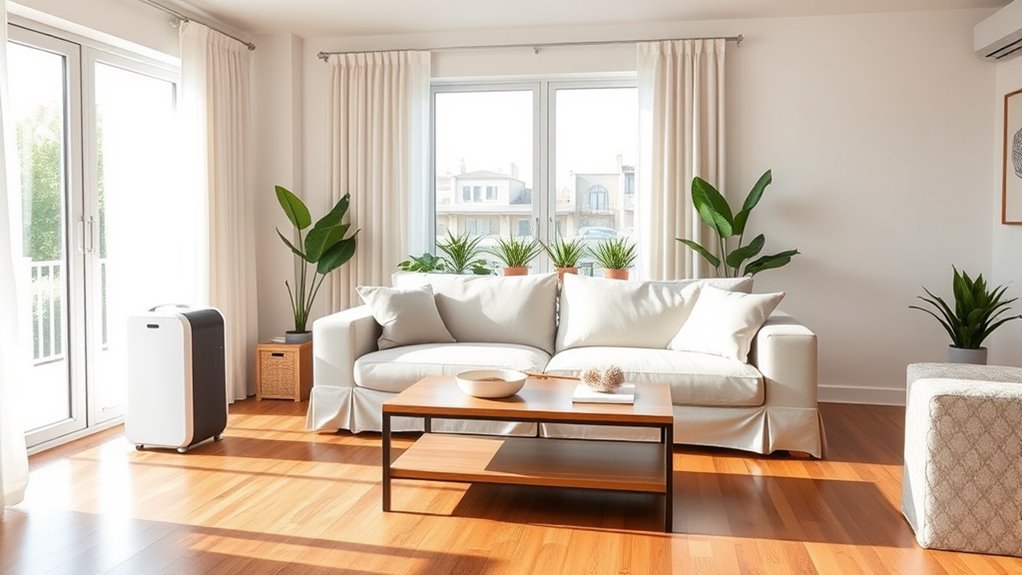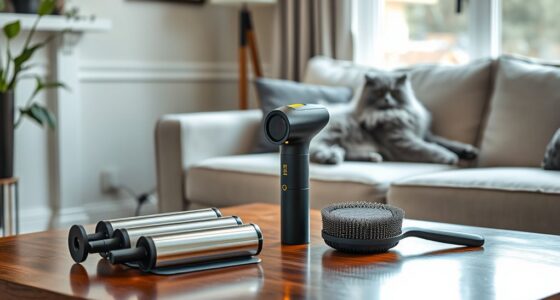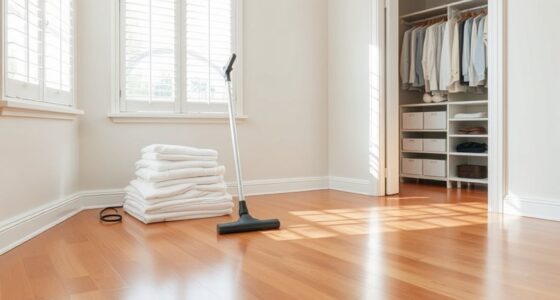To allergen-proof your home in 7 simple swaps, start by using allergen-proof mattress and pillow covers to block dust mites. Replace heavy, dust-trapping curtains with washable blinds or lightweight fabric. Swap carpets for hard flooring surfaces like wood or tile that are easier to clean. Use HEPA-filter air purifiers and regularly change HVAC filters. Opt for natural cleaning products and wash bedding often. These small changes can make a big difference for allergy relief—discover more tips as you continue.
Key Takeaways
- Replace regular bedding with allergen-proof covers and wash in hot water weekly.
- Switch heavy curtains to washable blinds or lightweight, machine-washable curtains.
- Opt for hard flooring like hardwood or tile, and vacuum with HEPA filters twice weekly.
- Use HEPA air purifiers and regularly replace HVAC filters to improve indoor air quality.
- Choose natural, hypoallergenic cleaning products and maintain a routine of daily cleaning and ventilation.

Are allergens sneaking into your home and triggering your symptoms? It’s a common problem, but the good news is that you can make simple swaps to reduce your exposure. Small changes in your daily routine and household items can make a big difference in creating a healthier environment. Start by swapping out your regular bedding for allergen-proof covers. These special covers create a barrier that prevents dust mites and pet dander from settling into your mattress and pillows. It’s a straightforward change that can considerably cut down on common indoor allergens.
Next, consider switching to washable curtains or blinds instead of heavy drapes. Curtains tend to trap dust and pet hair, making them tough to clean thoroughly. Opt for blinds or shades that you can easily wipe down regularly. If you prefer curtains, choose lightweight, machine-washable fabrics and wash them weekly in hot water to remove accumulated dust and allergens. This simple swap keeps your window coverings cleaner and allergen-free.
Switch to washable, lightweight curtains or blinds for easier allergen control and cleaner window coverings.
When it comes to flooring, replace wall-to-wall carpets with hard surfaces like hardwood, tile, or laminate. Carpets tend to trap dust, pollen, and pet hair, which can be difficult to eliminate completely. Hard floors are easier to keep clean and require only regular sweeping and mopping. If replacing your flooring isn’t feasible, consider using a vacuum with a HEPA filter. These vacuums trap tiny particles that standard models may recirculate into the air, helping to reduce airborne allergens. Make a habit of vacuuming carpets and rugs at least twice a week to prevent dust buildup.
Switching to air purifiers fitted with HEPA filters is another effective step. These devices capture airborne allergens like pollen, pet dander, and mold spores, reducing what you breathe in. Place them in rooms where you spend most of your time, especially bedrooms and living areas. Also, replace your HVAC filters regularly with high-quality, allergen-reducing filters. This keeps the air circulating in your home cleaner and minimizes allergen circulation.
Finally, be mindful of your cleaning products. Swap harsh chemical cleaners for natural or hypoallergenic options. Using less aggressive cleaners reduces the chance of irritating your respiratory system. Incorporate daily habits like wiping down surfaces, vacuuming, and washing bedding frequently. Regularly ventilating your home helps to remove indoor pollutants and improve air quality. These small but consistent actions help create a cleaner, allergen-resistant environment. By making these simple swaps, you can markedly reduce indoor allergens, breathe easier, and enjoy a healthier home.
Frequently Asked Questions
Can I Allergen-Proof My Home on a Tight Budget?
Yes, you can allergen-proof your home on a tight budget. Start by regularly cleaning with a HEPA vacuum, which helps trap allergens like dust and pet dander. Wash bedding weekly in hot water and keep windows open to improve airflow. Use affordable air purifiers and declutter to reduce dust accumulation. Simple changes like these can markedly reduce allergens without breaking the bank.
How Often Should I Replace Allergen-Proof Bedding?
You should replace allergen-proof bedding every 6 to 12 months, or sooner if it shows signs of wear. Think of it as your secret weapon against relentless allergens lurking in your sleep sanctuary. Regular washing helps, but over time, the materials break down and lose their barrier effectiveness. Don’t wait until allergens invade—make it a habit to refresh your bedding for a healthier, more restful night’s sleep.
Are Natural Cleaning Products Effective Against Allergens?
Yes, natural cleaning products can be effective against allergens if used correctly. Look for ingredients like vinegar, baking soda, and essential oils, which help neutralize dust, mold, and pet dander. Regular cleaning with these products reduces allergen buildup and improves indoor air quality. However, make certain you follow instructions carefully and clean frequently to maintain an allergen-free environment, especially if you or family members have sensitivities.
What Are the Best Air Purifiers for Allergy Sufferers?
You should look for air purifiers with HEPA filters, as they effectively trap airborne allergens like pollen, pet dander, and dust mites. Brands like Honeywell, Winix, and Blueair offer highly-rated models suitable for allergy sufferers. Make sure to choose a purifier appropriate for your room size and run it continuously, especially during peak allergy seasons, to improve your indoor air quality and reduce allergy symptoms.
Can Pets Be Allergen-Proofed From Indoor Allergens?
A stitch in time saves nine, and that’s true for pet allergen-proofing. You can reduce indoor allergens by bathing your pets regularly, grooming them outdoors, and keeping their bedding clean. Use HEPA filters, vacuum frequently, and designate pet-free zones to minimize allergens. While you can’t eliminate all pet dander, consistent cleaning and precautions substantially lessen your indoor allergen exposure, making your home more comfortable for everyone.
Conclusion
So, after all these simple swaps, you might think your home’s now allergen-proof. Ironically, it’s almost like inviting allergens to stay — they’ve become part of the décor. But don’t worry; even if you can’t eliminate every sneaky particle, these small changes still make a big difference. After all, perfection is overrated. Instead, embrace your allergen-reduced haven, where comfort and a burst of fresh air are just a few clever swaps away.









